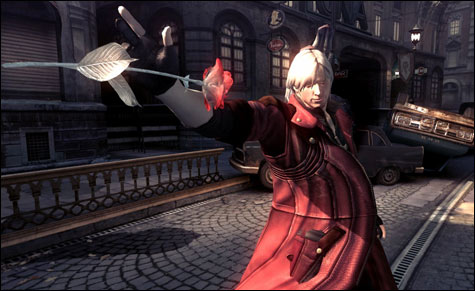
DEMONIC: The game’s take on religion is so far over the top that even Bill Donohue probably won’t take it personally.
|
For the truly hardcore — those gamers who thrive on punishing difficulty — the Devil May Cry series is godhead. Mastering its combat-heavy action gameplay requires swift reflexes, manual dexterity, and infinite patience. At least, it used to. The newest game, Devil May Cry 4, makes itself more accessible to neophytes by introducing a playable character with a simplified control scheme, plus less challenging default settings. The result is a solid hack-and-slash that stacks up well against the competition but loses some of what made its predecessor so special.
The new character is named Nero, though it’s tough to tell much of a difference between him and the series’s usual protagonist, Dante. Both are platinum-blond smart-asses with superhuman powers and swords the size of kayaks. And both seem to share a demonic lineage that requires them to take on the corruption of the ruling religious class. Say this for Devil May Cry 4’s story line: it’s not subtle. Nero and Dante are both cast as smirking rebels, and never is this more apparent than when Nero suggests to a pope-like figure, “Go blow me!” It’s so far over the top that even Bill Donohue and the Catholic League probably won’t take it personally.
Controlling Nero is substantially easier than the complex machinations required to manipulate Dante. Unlike Dante, Nero is stuck with the same sword and gun throughout the game, with two unique attributes of his own. “Exceed” allows him to power up his sword’s strength by revving its handle like the accelerator of a motorcycle. The other attribute is Nero’s multifaceted, demonically possessed right arm: its “Devil Bringer” feature can grab nearby foes and yank them into melee range, and its “Buster” power produces a devastating blow or hold, depending on the enemy. The Devil Bringer is a lot of fun, particularly as it lends itself to extended aerial combat, but it also lets Nero dictate the pace of most fights in a way that makes the game a little easier and less skillful. You still can’t button-mash your way through, but it sure doesn’t hurt.
It’s a welcome change, halfway through, when the game puts you back in Dante’s familiar boots. Defense and evasion are more important to his style of combat, so precise timing becomes crucial — and you have the advantage of pinpoint play control. Because Dante can swap his swords and firearms instantaneously, and switch among four different fighting styles with the push of a button, playing as him is also more rewarding. The one problem is that you take control of Dante only to backtrack through all the levels you’ve visited before. You’ll go several missions without encountering any new sights. You’ll even fight the same bosses, usually in the same settings.
For a fairly short game, it’s surprising how much Devil May Cry 4 recycles. You’ll face those bosses three times each. Most levels consist of a string of hemmed-in fights against identical hordes of demons, and the puzzles are never more complex than transporting a key item from one location to another. Once you understand the rhythms of the game, only an epic final boss battle is truly surprising, but it is worth getting there: picture the Colossus fight from God of War II on an even bigger scale. This is an argument for the value of high-definition graphics — if not necessarily for a Devil May Cry 5.